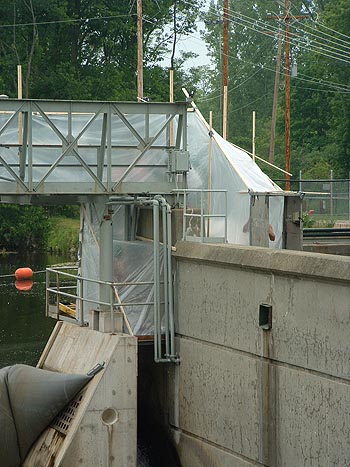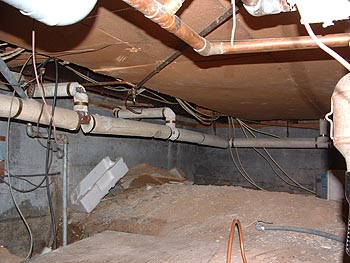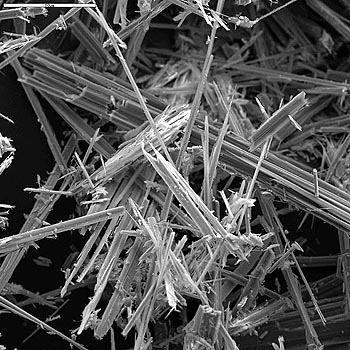Asbestos refers to a group of naturally occurring fibrous minerals, that when mined and processed, can be separated into very small (microscopic) fibers. Asbestos was once referred to as the “Magic Mineral” because it will not burn, resists corrosion, is an excellent insulator and possesses high tensile strength. Asbestos use in the United States dates back to the late 1800’s. Commercial use peaked from the early stages of World War II until the 1970’s during which time it was used in thousands of different products. Although asbestos use is significantly diminished today (2010), there are not yet blanket use restrictions. Therefore, some products sold today may still contain asbestos fibers.
The Environmental Protection Agency (EPA) classifies asbestos containing building materials into three general categories – Thermal System Insulation, Surfacing Materials, and Miscellaneous Materials. Thermal System Insulation refers to materials applied to pipes/pipe fittings, boilers, tanks, ducts, or other HVAC system components, to prevent heat loss/gain and condensation. Examples of Surfacing Materials include sprayed-on fireproofing insulation and plaster. Miscellaneous Materials include all other materials that are not Thermal System Insulation or Surfacing Materials. Examples of Miscellaneous Materials include ceiling tiles, floor tiles/adhesive, linoleum, sheet rock/joint compound and roofing materials, among many others.
Unfortunately, historical observation and medical research has documented that the magic mineral has a dark side. Asbestos exposure causes disease in some humans. This information was supressed by manufacturers during the time when asbestos use was most abundant, but became public knowledge during the late 1960’s based on studies of shipyard workers in the Northeast. Diseases which have been linked to exposure to asbestos fibers include asbestosis (progressive, fibrotic scarring of the lungs), lung cancer and mesothelioma (cancer of the lining of the lung). Asbestosis and lung cancer are known to be caused by relatively high levels of exposure over relatively long periods of time. Mesothelioma may be caused by relatively short/low levels of exposure.
Asbestos is a potential hazard when fibers become airborne and are inhaled through normal breathing. Asbestos materials that are intact (i.e., not damaged) and undisturbed do not present a health risk. The EPA encourages in-place management of asbestos in school buildings in accordance with 40 CFR Part 763. If not properly managed/maintained, however, asbestos materials may become damaged or may deteriorate over time, creating a potential hazard for building occupants/workers. In addition, unplanned disturbance by improperly trained construction/maintenance personnel may be problematic. Even a minor asbestos disturbance can contaminate a building.
Medical data and other factors have compelled regulatory agencies to develop comprehensive asbestos regulations to protect the environment, workers, and building occupants (EPA, OSHA, DOT and State regulations) from contracting asbestos related diseases. The regulations are complex and comprehensive and even extend into personal dwellings. If you are not licensed or certified to inspect or handle asbestos, you should rely on qualified firms/individuals to assist with asbestos management decisions you may require. As a rule, it is better to leave asbestos in place than handle it improperly.
State and Federal Regulations require the performance of an asbestos inspection prior to the start of any renovation and demolition activities. The presence/absence of asbestos in building materials can only be confirmed through microscopic analysis of a small sample of the material in question. An asbestos inspection must be performed by a certified asbestos inspector.
Clay Point Associates, Inc. (CPAI) is a Vermont owned environmental consulting firm that has provided professional asbestos management services for the past twenty two (22) years. Our consultants have a combined forty two (42) years experience working with asbestos. We are not affiliated with any contracting firm. Therefore, we provide objective services without any conflict of interest.
If you are planning a home renovation, or larger construction project, or have other reasons to know, CPAI is available to perform an asbestos inspection on your behalf. If asbestos is found to be present and will be disturbed or contacted during a renovation project, it must be properly removed. All asbestos must be removed from a building prior to demolition. CPAI is available to provide abatement recommendations for in-place management or removal. Budget estimates for these recommendations can also be generated. If abatement is required, CPAI can provide project planning, project design and project management services. This includes development of some form of design/bid documents and administration of a competitive contractor bidding process with qualified contractors. As a rule, our costs associated with bid process administration are recovered by creating equal, competitive bidding conditions for abatement contractors. If you involve CPAI in this process, you will receive fair pricing from abatement contractors.
Once an abatement project begins, CPAI can perform on-site project monitoring of the abatement contractor’s activities as well as perform various project management activities. In addition, we conduct all project clearance activities including the required visual inspection and clearance air sample collection/analysis.
Proper asbestos management is a complicated issue.
Please contact us to discuss any questions you may have.
Asbestos Links:





